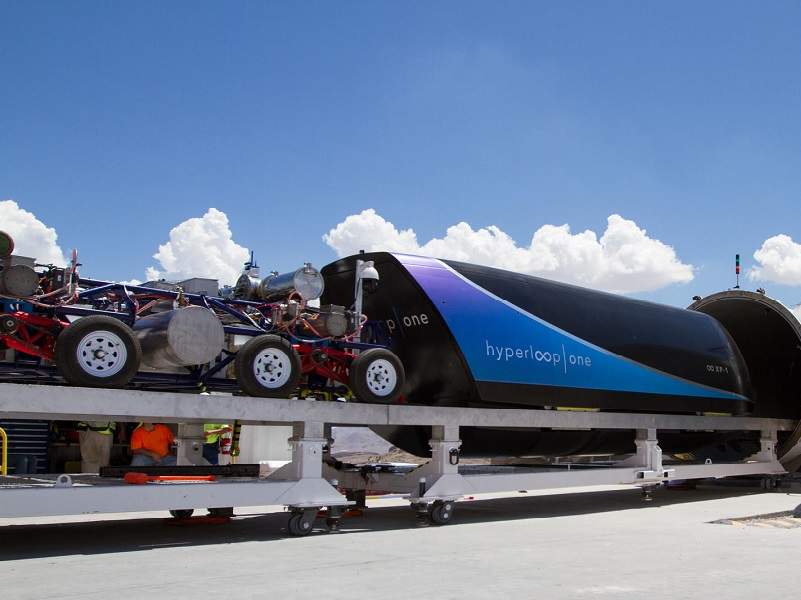
Virgin founder Sir Richard Branson recently unveiled plans to bring high-speed Virgin Hyperloop trains to the UK, claiming they could revolutionise the country’s outdated railway system by connecting at speeds of almost 700mph.
The proposed system involves the use of pods travelling through electro-magnetic tracks that are protected by a low-resistance tube with very low air pressure.
These train pods are currently being trialled in the US and tests over its feasibility on intercity routes between Chicago, Columbus and Pittsburgh were announced earlier in July.
A successful implementation in America could pave the way for the hyperloop technology to be implemented across the ocean. With the president of Virgin Hyperloop One Colin Rhys recently suggesting opportunities to introduce them into Europe, the chance of seeing the technology in the UK might soon become a reality.
We spoke to Leslie Horwitz, strategic communications manager at Virgin Hyperloop One, to find out if the UK could become the first country to host the pods.

How well do you really know your competitors?
Access the most comprehensive Company Profiles on the market, powered by GlobalData. Save hours of research. Gain competitive edge.

Thank you!
Your download email will arrive shortly
Not ready to buy yet? Download a free sample
We are confident about the unique quality of our Company Profiles. However, we want you to make the most beneficial decision for your business, so we offer a free sample that you can download by submitting the below form
By GlobalDataAdele Berti: What are the main characteristics of hyperloop?
Leslie Horwitz: Hyperloop is a new mode of transportation that moves freight and people quickly, safely, on-demand and direct from origin to destination. Our hyperloop vehicle can carry passengers or cargo and accelerate gradually via electric propulsion through a low-pressure tube. The vehicle floats above the track using magnetic levitation and glides at airline speeds for long distances due to ultra-low aerodynamic drag. It’s fully autonomous and enclosed, eliminating pilot error and weather hazards. It’s safe and clean, with no direct carbon emissions.
AB: What makes the UK a suitable place for hyperloop pods to operate and what benefits would they bring to the country?
LH: We see tremendous promise in countries like the UK. It’s one of the reasons two UK routes were selected as winners of our Global Challenge last year. One route, the ‘North-South’ Connector, would run through London, Birmingham, Manchester and Edinburgh, forming a spine of a national hyperloop network. The proposal highlighted that by connecting metro areas across northern UK, the North-South Connector would stimulate growth and bring much needed economic balance to the UK.
The other route, named the ‘Northern Arc’ would connect Glasgow to Liverpool in under an hour – with stops in Edinburgh, Newcastle, Leeds and Manchester. The proposal aims to bridge the gap between the M62 Corridor and the Scottish Central Belt, with Newcastle as the nexus. The corridor could effectively create a new megaregion of over a million people, competitive globally with the London metro area.
AB: To what extent would they impact the country’s landscape?
LH: The system’s space-saving design can be elevated above or below grade lower environmental footprint and secure right-of-way.

AB: What are the differences between hyperloop trains and the upcoming HS2 trains, which will be introduced in the UK in the next years?
LH: There are four key differences. It’s faster, as in two to three times faster than the fastest high-speed rail. It’s on-demand and direct. Trains follow a schedule and typically have multiple stops. Hyperloop pods can depart up to several times per minute and can transport passengers and cargo direct to their destination with no stops along the way.
It’s environmentally friendly, with a smaller civil engineering footprint, more efficient energy consumption and no direct emissions or noise. It’s less expensive to build and operate: high-speed rail and maglev [magnetic levitation] trains require power along the entire track and a heavier engineering structure. Hyperloop only requires energy along a portion of the track and a lighter engineering structure. As a result, hyperloop systems cost less to build and operate. Virgin Hyperloop One systems achieve better performance for less cost.
AB: An engineer recently claimed: “Hyperloop is like building a motorway but only letting Rolls-Royces use it. Hopeless.” How do you respond to those who consider them as unfeasible for the UK?
LH: As the first new mode of public transportation in 100 years, our goal is to make hyperloop travel affordable for everyone. It’s difficult to predict a more exact price at this time given numerous factors including the route, but some estimates have found the cost similar to an intercity bus ticket.
AB: How could hyperloop impact the UK’s infrastructure and connections with Europe post-Brexit?
LH: Our goal is to have Virgin Hyperloop One systems connect to existing modes of transport such as metros, rail and airports to enable fast, effortless journeys.



